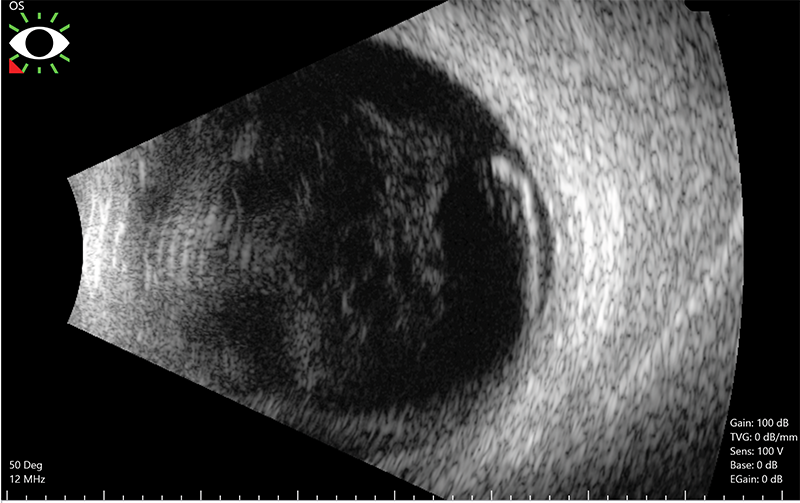Retinal Tears
 ultrasound of a large retinal tear
ultrasound of a large retinal tear
What is a Retinal Tear?
The retina is the layer of specialized nerve tissue lining the back of the eye that allows you to see. The vitreous is a gel-like substance inside of the eye. A retinal tear occurs when the vitreous gel tugs on the retina causing it to tear. If there are retinal blood vessels at the location of the retinal tear, bleeding will occur inside the eye.
What causes a Retinal Tear and who is at risk?
Retinal tears can develop at any age but tend to occur more commonly in the elderly. Tears typically occur when the vitreous gel separates from the retina. This separation is a natural aging process in the eye and is called a posterior vitreous detachment (PVD). Most PVD’s cause no long-term damage to the eye but in some individuals, PVD results in retinal tears. Tears are also more likely to occur in people who are near-sighted (myopic), after an injury to the eye, or in conditions where there is an abnormally strong attachment between the retina and vitreous. Tears are also more common in people who have a history of previous retinal tear or a family history of retinal tears or detachments.
What are the symptoms of a Retinal Tear?
Retinal tears are painless. The symptoms of a retinal tear and a PVD are essentially the same. Retinal tears can cause new floaters, intermittent flashing lights, cobwebs and perhaps a shower of black dots. The flashing lights are typically much more noticeable at night or in the dark, while floaters are usually much more noticeable in strong light. Some people have a lot of these symptoms while others notice hardly anything at all.
How are Retinal Tears treated?
Small holes and tears are usually treated with laser surgery. Laser is used to create tiny burns around the retinal tear. After the laser treatment, the healing process essentially spot-welds the retina down and prevents the tear from causing a retinal detachment. Occasionally it is not optimal to use the laser. In those situations, a freezing procedure called cryopexy is used to treat the retinal tear instead. It can take up to a week for the laser treatment to seal the retinal tear, and a period of decreased activity for about 10-14 days is recommended. Since most retinal tears occur in the setting of a PVD, it is possible to develop another retinal tear or detachment within a few weeks or months after the first tear. Most retinal tears occur in the far outer edges of the retina called the peripheral retina. Luckily, the peripheral retina is a part of the retina that is normally not used to see with. Therefore, most of the time patients will not notice a change in their peripheral vision from the tear or the laser treatment. Additionally, it is important to note that the laser treatment does not treat the floaters or flashing lights. These typically resolve gradually on their own over a period of weeks to months. It is very important that if you notice any big increase in floaters, flashes or a loss of the peripheral or side vision that you notify your retina specialist.